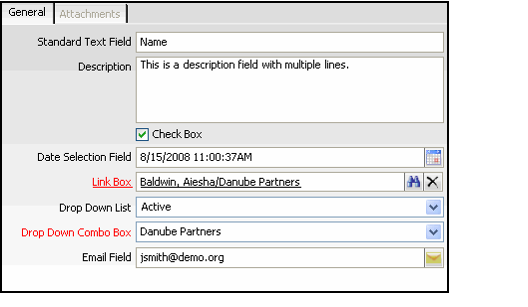Defining Entity Fields
The information you enter on a Fields record determines the type of field that appears on the form that Aptify automatically generates for the entity. These field types generally correspond to Aptify's bound controls. Note that non-updateable fields (that is, fields with the Updateable option is cleared) do not appear on generated form but they can be added to a form manually using the Visual Designer (see Modifying Field Layout with the Visual Designer for more information).
This topic contains the following sub-topics that provide general instructions for creating a new field, describe the configuration settings required for a field to adopt a particular field type, and provide a listing of supported SQL data types:
- General Steps for Creating a Field
- Creating a Field of a Specific Type
- About the Supported SQL Data Types
The common entity field types include:
- Standard Text Field: This is a standard text field.
- Multi-Line Text Field: This is a text field that supports multiple lines, such as a Description field.
- Check Box: This is a checkbox that a user can select or clear.
- Date Selection Field: This field stores a date and time; it includes a calendar icon so users can scroll through the calendar to select a date.
- Link Box: This field provides a link to another entity. Typically, a linked field links to another entity's ID field. This field creates a foreign key and establishes a one-to-many relationship between the new entity and the related entity. However, since the link is based on ID, you generally also want to create a Joined Virtual Field for linked fields so the linked record's name appears in views rather than its ID.
- Standard Combo Drop-down List: This field displays a list of static field values.
- Data Combo Drop-down List: This field displays a list of field values, populated with records from another entity or database table. This drop-down menu can display one or more fields for each selection.
- Extended Attribute Fields: Aptify supports 16 extended field types. This includes address-related fields (such as a State or ZIP Code field) and field that present an icon that provides additional functionality when clicked (such as an Email or Object Repository field).
- Embedded Objects: As with a Link Box, this type of field provides a link to another entity and establishes a one-to-many relationship between the new entity and the related entity. However, when using an embedded object, the fields from the related entity appear on the new entity's form, as if they were fields in that entity. See Embedded Objects for more information.
- Calculated and Computed Virtual Fields: This is a field that is not stored in the database table. The system dynamically calculates the field's value based on a specified SQL expression at either the table level (Computed) or within the Base View (Calculated).
- Money Fields: A money field typically should be expressed in a particular currency type. This section describes how to configure a field and specify that its values can support multiple currencies.
See Selecting Fields for information on how to use the standard field types.
Developers can refer to the Aptify.Framework.WindowsControls namespace in the Aptify Software Development Kit (SDK) for more information on the Aptify bound controls.
Related content
Copyright © 2014-2019 Aptify - Confidential and Proprietary
